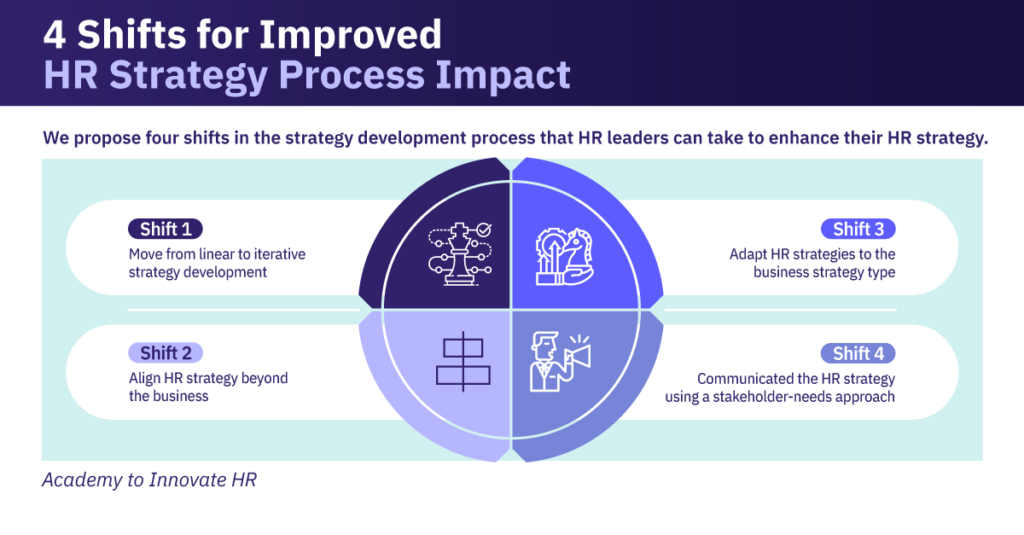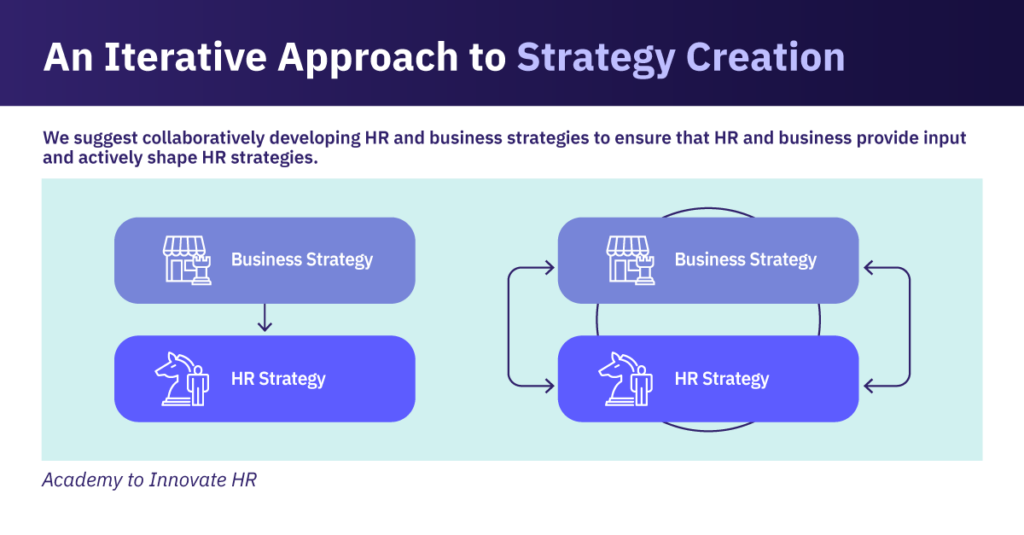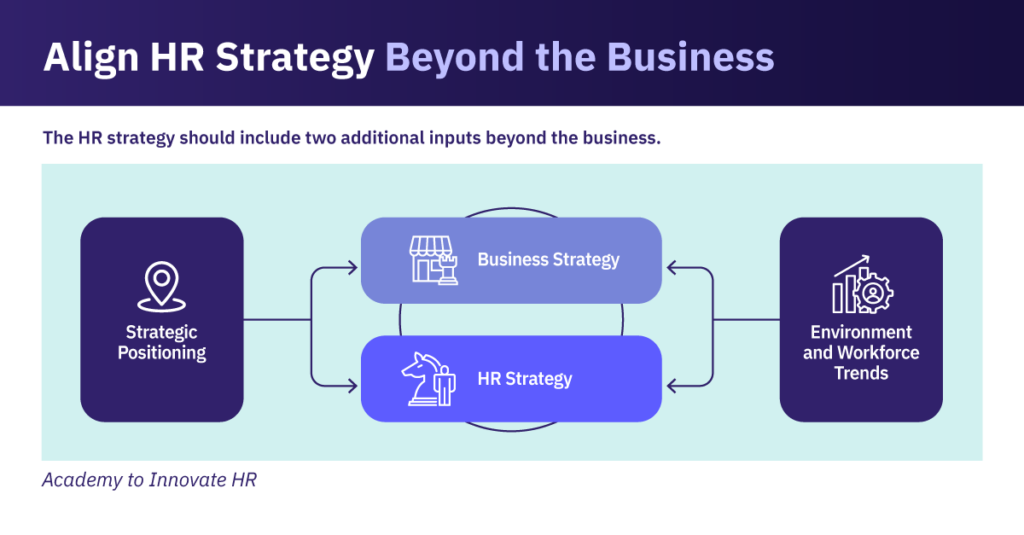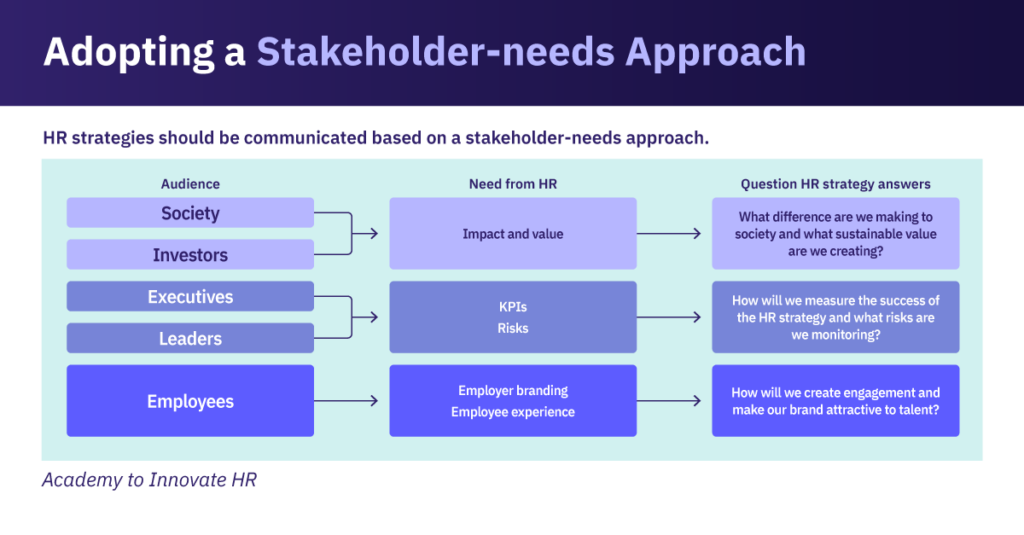HR strategy research insights at a glance
Based on our analysis of 50 top-performing companies, we recommend four shifts HR leaders must adopt in the strategy development process:
- Shift 1: Move from linear to iterative strategy development
- Shift 2: Align HR strategy beyond the business
- Shift 3: Align HR strategies to the business strategy approach
- Shift 4: Communicate using a stakeholder-needs approach
Our analysis of 50 top-performing companies reveals that they have successfully avoided two common pitfalls in HR strategy development that often lead to HR strategy failures.
First, these successful companies don’t just respond to immediate business needs; they also consider other factors, such as changing labor markets, new technologies, and the political climate, when shaping their HR strategy. Second, they successfully convey HR objectives to stakeholders at all levels in a way that demonstrates their strategic value.
The insights highlight that HR must navigate a new paradox in HR strategy development. On the one hand, it must closely align with the business to understand its needs and communicate HR’s impact. On the other hand, it also needs to consider the broader external environment and the increasingly complex landscape of stakeholders beyond the business.
To tackle these challenges, we recommend four shifts in the strategy development process that HR leaders can adopt to make their strategies more relatable, relevant, and credible.

Shift 1: Move from linear to iterative strategy development
Developing an HR strategy has traditionally been a linear, reactive process designed to respond to the business’s needs. This usually means the CHRO actively participates in the business strategy process and then creates the HR strategy based on those outcomes.
However, this reactive approach comes with several challenges.
Additionally, CHROs point out that this method often ignores external influencing factors, leaving HR unprepared for changes in the environment or unexpected events.
On the other hand, when the HR strategy is developed after the business strategy process, HR is positioned as a business strategy enabler, not a co-creator or partner. As a result, HR initiatives are not included in the core business strategy, and key business stakeholders are not involved. This lack of involvement often results in a lack of buy-in and investment in HR initiatives.
To address this issue, we suggest a more iterative approach to strategy creation. This means developing HR and business strategies collaboratively, ensuring that HR provides input into business strategy while business leaders actively help shape HR strategies.

By adopting this iterative approach, HR strategy development can occur alongside business strategy development rather than afterward. This concurrent process fosters better alignment and integration of both strategies, leading to a more cohesive and effective business strategy.
This approach encourages HR leaders to develop their strategy in collaboration with the business. It fosters higher levels of buy-in, essential input during the HR strategy process, and more clarity from business leaders on the focus areas for HR.
Get started
- Identify the business stakeholders you want to include in the HR strategy process
- Plan for an iterative HR strategy cycle, developing your HR strategy in collaboration with the business strategy process.
Shift 2: Align HR strategy beyond the business
To be more adaptable, the HR strategy should extend beyond just the focus areas of the current business strategy. We propose incorporating two additional inputs:
Approach 1: Strategic positioning
Strategic positioning means aligning the HR strategy with the organization’s core principles that guide decisions and priorities. Organizations have different positioning options regarding markets, products, and clients.
While all three are important for success, how they are prioritized affects the focus of business strategies and how HR can influence business objectives. Let’s further expand on this:
The priority: Product > Client > Market
- The implications: We build outstanding products for specific markets, with a competitive advantage rooted in product design and senior-level technical expertise. However, this focus may create a blind spot in client service and sales engagement despite having a superior product suite compared to competitors.
- The impact on HR strategy: HR strategy should focus on people, talent, and skills as the key differentiators, including the long-term impact of innovation on the industry.
The priority: Client >Product>Market
- The implications: A client-centric organization closely aligned with the client ecosystem competes primarily in client service and sales. Its expertise lies in client engagement, focusing on clients rather than product features. While its products are competitive, the organization may have a blind spot in product innovation and is unlikely to achieve a first-mover advantage.
- The impact on HR strategy: HR strategy should focus on developing and retaining client-facing employees, ensuring a high-performance sales and client relationship-driven culture.
The priority: Market>Product>Client
- The implications: This organization specializes in serving a specific market persona, such as high-income individuals, by developing niche products tailored exclusively to this segment. These products meet the needs of this particular client type but are not designed for other segments. This organization’s potential blind spot is its limited ability to expand into different segments or create scalable products. Additionally, they may focus on protecting their client segment from competitors rather than pursuing broader growth. Their value proposition is rooted in exclusivity rather than scale.
- The impact on HR strategy: HR strategy should focus on differentiating through the performance of the workforce and how to make the organization attractive in the market for critical and scarce talent
By understanding these choices, HR can better prioritize and assess the importance of specific strategic priorities, ensuring they align with the core principles that will underpin the business strategy. This, ultimately, ensures alignment between the organization’s purpose and identity and what is prioritized and communicated in the HR strategy.

2. External trends and workforce
A proactive HR strategy needs a deeper understanding of external trends that directly impact HR and the business. For example, shifts in labor markets, an aging population, and advancements in generative AI bring new risks that will shape HR strategies in various business contexts.
These trends also impact workforce regulations, which HR must include in their plans. Also, the growing emphasis on environmental, social, and governance (ESG) factors requires a robust HR response and a proactive role in shaping business strategy with these mandates in mind.
This can change how HR engages in the business strategy process, providing valuable perspectives that inform business decision-making related to strategic priorities.
Get started
- Monitor external trends relevant to your industry and business context and determine the risks to consider in your current HR strategy
- Understand the underpinning positioning principles of the business and evaluate if the HR strategy is aligned with those priorities.
Shift 3: Align HR strategies to the business strategy approach
Business strategies can take different forms and are designed to address specific goals or challenges using a defined approach. This sets the direction for the strategy development, guides organizational actions, and ensures effective execution.
It’s essential that the HR strategy aligns with the business’s strategic approach and type to ensure effective integration and alignment.
For instance:
- A business that adopts a visionary strategy approach will require an HR strategy that emphasizes innovation. This means embracing non-traditional talent and performance strategies that reward innovative behaviors and delivery. In contrast, a cost containment strategy will focus on HR efficiency metrics like the cost of hire, turnover, and HR service delivery.
- A strategy centered on diversification will incorporate metrics related to measuring new project initiatives, the increased impact of innovation through HR practices, and how well the company culture fosters new product development.
Here’s an overview of some of the more known business strategic approaches and how HR strategies should adapt to them:
Classic: Distinct phases of analysis, planning, and execution, making it ideal for a predictable and stable context.
Structured recruitment and development processes, emphasis on clear roles, and employee performance metrics aligned with strategic goals.
Disruptive: Imagination to create groundbreaking products, services, or business models and is followed by persistent efforts to develop a market suitable when a firm can significantly influence its environment.
Focus on attracting innovative and risk-taking talent, fostering a culture of creativity and experimentation, and providing continuous learning and development opportunities.
Evolutionary: continual experimentation and scaling up successful initiatives, fitting for unpredictable environments.
Agile HR practices promote flexibility and adaptability, encourage a fail-fast mindset, and support cross-functional collaboration.
Process: strategy is more of an emergent process than a deliberate plan.
Emphasis on continuous improvement and repeatability of processes. HR focuses strongly on setting procedural foundations and adapting those over time.
Cost containment: reducing expenses to improve profitability without sacrificing the quality of products or services.
Focus on efficiency and productivity, optimizing workforce management, implementing cost-effective training programs, and fostering a culture of continuous improvement.
Blue Ocean: Creating uncontested market space and making competition irrelevant.
Talent acquisition focused on creative and strategic thinkers, promoting a culture of innovation and collaboration, and aligning incentives with strategic innovation goals.
L’Oréal USA harnesses its diverse workforce to drive product innovation
At L’Oréal USA, product innovation is a key pillar of their business strategy. This means the business focuses on finding new and unique ideas that can drive product innovations and gain access to new markets.
The HR strategy is focused on Diversity, Equity, Inclusion, and Belonging in response to the business strategy. Recognizing that a diverse workforce is a key driver of innovation, L’Oréal has strategically incorporated diverse perspectives into all aspects of its business.
This focus is reflected in how they bring new talent on board as well as gaining diverse perspectives from employees to inform their product innovation.
L’Oréal’s commitment to diversity and inclusion is encapsulated in their formula: DIVERSITY + INCLUSION = INNOVATION & SUCCESS®.
Two of their key strategies include:
- Diverse talent recruitment: L’Oréal actively recruits diverse talent through campus engagements, strategic partnerships, and participation in national diversity recruitment fairs. This includes connecting with over 3,000 students annually and maintaining networks with groups such as Junior Military Officers and women in science.
- Utilizing diverse perspectives: L’Oréal recognizes the importance of using its diverse workforce in product development. For example, a research project led by Balanda Atis focused on creating suitable foundation shades for women of color. This led to the development of products like the True Texture line for natural curly hair, which arose from extensive research on different hair types.
By making Diversity and Inclusion central to their HR strategy, they foster a diverse and inclusive workforce and harness their unique perspectives to meet the varied needs of their consumers. This strategic alignment of HR and business goals ensures ongoing innovation and success in reaching new markets.
Get started
- Identify the type of business strategic approach that has previously been followed
- Decide on the type of approach you will adopt going forward
- Evaluate your current HR strategy against the chosen approach.
Shift 4: Communicate using a stakeholder-needs approach
As HR’s role and scope have changed, there is an increasing need to navigate a complex stakeholder environment. In the past, communicating HR strategies has often been tough. Many strategies were mired in jargon or failed to clearly connect HR activities to business objectives.
To improve this, HR strategies should be communicated by focusing on a stakeholder-needs approach. This means that the specific needs and interests of the relevant stakeholder groups should shape how HR communicates its strategies. HR can simplify its messaging to be clear and concise, making sure it connects with each stakeholder effectively.
In practice, the HR strategy should consider the needs of the following stakeholders:

Keeping a consistent overarching message is key for strategic communication. but it needs to be tailored to the target audience. This should be evident in the overarching strategy, the strategic objectives relevant to the stakeholder group, and how success is measured. No matter the audience, the HR strategy must clearly articulate value to them.
Walmart is a great example of this approach, especially in how it outlines its ESG impact.
Walmart adopts a stakeholder-needs approach to Human Capital and ESG
One of Walmart’s strategic focus areas is ESG. They describe this strategic focus area as “Good Jobs & Advancement for Associates,” which reflects their commitment to developing skills within their organization and the communities they represent.
They have translated this strategic focus area for their stakeholder landscape based on their needs, interests, and definition of success.
- Society and investors: They describe the relevance of this focus area to business and society by focusing on their workforce’s role in delivering their overall mission to help people save money and live better. To address this audience, they focus on the number of employees within their workforce and the importance of investing in their development and overall careers. They discuss investments, creating value beyond Walmart, and sustaining local economies.
- Executives: They further translate this strategic focus area to describe the cost-benefit associated with upskilling and how this approach mitigates and manages the very prominent risk of skills shortages. They reflect their efforts against key performance indicators (KPIs) and progress measures by reporting on upskilling initiatives in quantifiable terms.
- Leaders: They distill this strategic focus area into distinct principles, including upward mobility, to address barriers within the workforce. These principles shape the shared priorities of HR and leadership to create a culture that supports this strategic focus area. They highlight belonging, well-being, growth, and strengthening their frontline workforce.
- Employees: These core principles are translated into practices that shape the overall employee experience and employer brand. A critical practice that is highlighted is ‘access to employment.’ They outline various processes related to the hiring process that bring this to life. In this case, they include streamlining the application process, valuing skills and knowledge, countering degree inflation, and committing to second-chance employment of formerly incarcerated applicants. A prospective or current employee can see what this HR strategic focus area means to them.
Get started
- Identify the stakeholders relevant to your HR strategy
- Develop the specific messaging for your HR strategy aligned to the stakeholder needs.
Final words
Redesigning HR strategy needs an iterative and integrated approach that matches business needs and the external environment. By shifting from a linear to an iterative process, HR can actively shape business strategies and adapt to changes in the labor market and regulations.
It’s important to customize HR initiatives to fit specific business goals and clearly communicate these strategies to stakeholders to gain their support and improve execution. By making these strategic changes, HR leaders can enhance alignment and contribute to long-term success for the organization.








